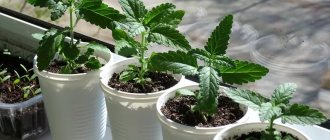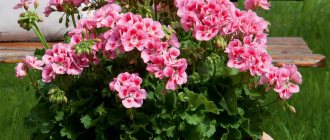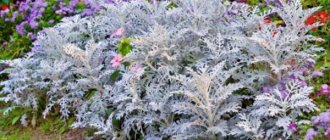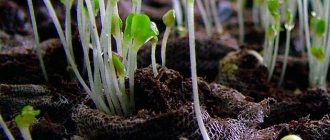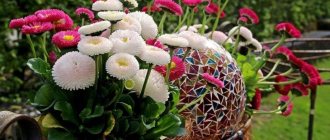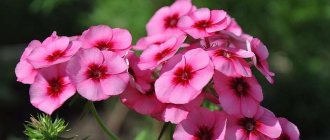Many gardeners like to plan their front garden or flower bed, that is, a combination of colors and sizes of flowers. Some experienced flower gardeners have concluded that carnations are perfect for any flower bed; they are a decoration for any flower arrangement.
But many questions arise about when to sow cloves for seedlings, when to plant them in open ground and how to care for them. You will find the answer to all these questions below, and so that you can definitely grow carnations, we share some tips and tricks.
Perennial carnation (lat. Dianthus) is widespread throughout the world. The botanical name of the herbaceous plant means divine flower
When to sow cloves for seedlings, in what month
If you really like carnations and want to plant them in your garden or vegetable garden, then most likely you are wondering when to sow cloves?
The best time to sow carnations is the end of January or the first days of February; some flower beds sow them in early March, but you don’t need to do this too late. The plant needs quite a long time to develop normally.
You also need to take into account the climatic characteristics of your region, for example, the optimal time for sowing in Moscow is mid-February, and in the southern regions the last days of January are suitable.
You can navigate according to the lunar calendar, this is very convenient, because you can immediately determine both favorable and unlucky days
Days on which it is best to sow seedlings:
- January – 27-29;
- February – 1-8, 10-20, 25-28;
- March – 2-14, 29-31;
- April – 1, 2, 5, 6, 7, 9, 18-20, 24, 25.
Days on which it is strictly forbidden to work in the garden:
- January – 10, 25,26;
- February – 9, 21, 22, 23;
- March – 9, 19, 20, 21,24;
- April – 8, 15,16, 17,23.
Variety selection
Nature has created about 300 types of carnations, but only about 10 are available for cultivation. The most common varieties of carnations are:
Turkish
This variety of carnation is a miniature bush on which many small inflorescences bloom.
The peculiarity of this variety is that inflorescences of completely different colors can be combined on one bush, from white to dark burgundy.
Growing Turkish carnation is absolutely no problem even for a novice gardener; it is easy to care for and grows quite quickly.
Cirrus
This variety of carnation came to us from the Alps, it looks quite unusual, and all because of its leaves with deep cuts. From a distance it may seem that these are not flowers, but terry balls.
Pinnate carnation is perfect for decorating paths or flower bed edges.
Chinese
The bluish tint is what makes this variety distinctive, the inflorescences come in different shapes, and the color usually ranges from white to dark red or burgundy.
The most common form of this variety is bicolor; many flower gardeners are confident that these are the carnations that can decorate absolutely any flower bed.
Chinese carnation
Dutch
This is a perennial variety of carnation, but this is not its only feature; it also blooms continuously, from the second half of June until the first frost.
Its color can come in a variety of shades, but the most common is red with a white border along the edge of the petals.
Dutch carnation
Turkish carnation in landscape design
Turkish carnation goes well with Alpine asters, rudbeckia and Carpathian bellflower. These flowers are good to use as a living border, flower beds, for decorating garden paths and lawns. Low-growing varieties are actively used to create alpine slides.
Tender and juicy Turkish carnations are suitable for growing even by novice gardeners. It does not require special care, but it looks advantageous in any flower bed. But you need to remember that cloves do not tolerate waterlogging and can rot. Compliance with the watering regime is the key to plant health.
Video - instructions on sowing Turkish clove seeds for seedlings and recommendations for caring for seedlings for plant development:
Features of cultivation
The peculiarity of growing cloves is that it does not require several stages of picking. Doing this at home is much easier than in the open ground.
Carnations are planted early, and not every region can boast of warm winters, so an additional source of heat and light will be required.
Selection of capacity
There are no strict requirements for the capacity, the main thing is that it is large, but not very deep. A regular plastic container or cardboard box works well.
After picking, the sprouts will need to be transplanted into separate pots or peat tablets, in which case they may be smaller but deeper.
Seed selection and preparation
When you come to the store to buy seeds, carefully inspect the packaging; there should be no damage to it. They may indicate that the seeds were transported or stored incorrectly, this leads to damage to the planting material, and bad material will not produce beautiful flowers.
Before planting, he recommends disinfecting the seeds; to do this, it will be enough to soak them in a solution of potassium permanganate for 15-20 minutes. Disinfection can avoid any diseases.
Disinfection of seeds before sowing
You can also treat the seeds with immunomodulators, they strengthen the plant’s immunity.
When purchasing a package of seeds, check for recommendations on the back; there should also be information about the manufacturer.
Soil preparation
Soil for carnations can be bought in the store; universal soil for flower crops is suitable for it. But you can do it yourself, for this you will need:
- River sand, it must be washed;
- Turf land;
- Peat;
- Humus.
Make sure that the soil is light and loose; it should allow moisture and air to pass through well.
After preparing the soil, it must be disinfected; to do this, it must be steamed for one hour.
Direct sowing
In order to create optimal conditions for carnation germination, you need to follow the following steps:
- If your container does not have drainage holes, then you need to create them, this will prevent water stagnation;
- Next, we create a drainage layer, but it should not be thicker than 2 cm;
- Fill the container with soil, but not to the very brim;
- Don't forget to moisten the soil with a spray bottle;
- After the liquid is completely absorbed, make small indentations;
- Plant seeds in the holes and cover with a small layer of sand;
- Do not forget that after all the procedures you also need to water;
- Create a greenhouse effect in your mini-garden by covering the container with a bag or lid.
Water for irrigation at all stages of planting must be infused and clean; in no case should you use tap water
How to sow correctly?
The process of sowing Turkish cloves is as follows - the seeds are placed in a small groove made in the soil and lightly sprinkled with earth. After this, it is necessary to create a greenhouse effect for the crops by placing the containers in a bag or covering them with a layer of film.
Turkish clove seeds. Photo used as illustration. Source: Yandex.Images
The containers are then sent to a room with moderate lighting and a temperature of about 18°C. Crops should be moistened periodically. As soon as the seedlings begin to emerge and surface the ground, the film is removed.
Important! Seedlings do not like direct bright sunlight and excess moisture, so these influences should be avoided as much as possible.
Tips for caring for her
Carnations do not require careful care, but they need constant watering and light, both before and after germination. In order for you to grow a large and beautiful carnation, you need to follow several rules:
- After sowing, place the container in a room with a temperature of 18-20 degrees;
- Watering before emergence should be done from a sprayer; the cloves should be watered when the top layer of soil dries a little; the soil should not be allowed to be too wet;
- It is necessary to ventilate the mini-greenhouse; to do this, just remove the lid for 20 minutes once a day.
With proper care, the first shoots can appear within 4-5 days
Irrigation scheme
Watering before the emergence of shoots should be done from a sprayer and only as the top layer dries, and after the first shoots appear, watering should be done even more carefully.
In no case should you pour too much water in too large a stream; the plant is very susceptible to fungal diseases, and excess moisture can become a catalyst for the occurrence of these diseases.
Water should not be allowed to get on the stems and leaves; it is best to water the sprouts from a syringe
Top dressing
The carnation will delight you with its beauty if you take care of it in a timely manner; in addition to watering, you can sometimes feed the plant. At the initial stage of cultivation, nitrogen-containing fertilizers are suitable.
It is best to choose complex fertilizers that contain all the necessary substances.
Fertilizers must be applied strictly according to the instructions on the package; intentionally increasing the dose will only harm the plant.
Picks
Picking should be done only when you see that the plants have developed sufficiently and can withstand transplantation. The first pick should be no earlier than the first two green leaves appear, and the second – four leaves.
Before picking, you need to treat the soil and container, this is necessary in order to avoid any diseases
Carnation transplantation scheme:
- Before replanting, water the soil thoroughly;
- Prepare the container for transplantation: make drainage holes and lay a drainage layer, and fill the container with soil;
- Next, look how much the root has grown and make a hole slightly larger than the entire root system;
- Move the sprout to a new container and dig down to the cotyledon leaves.
After the procedure, you need to let the plants adapt a little, then they can be treated with a growth stimulator solution.
Pests and diseases
Carnation has a fairly strong immune system; it is difficult for diseases and pests to defeat it. The cause of disease can be infection; to prevent this, it is necessary to disinfect the soil, container and seeds.
Another common cause of disease is frequent watering.
Rust. With this disease, red spots appear; to cure the plant, you need to remove the affected leaves and treat the plant with a solution of Bordeaux mixture.
Mosaic disease. Black and white spots, which later cause holes to form. This disease cannot be treated; the plant just needs to be thrown out and the planting site treated.
Fusarium. This disease can be identified by a change in the color of the leaves from green to yellow, and blackening of the stem is also observed. This disease also cannot be treated; the plant simply needs to be disposed of.
Many plants can die due to attack by aphids, mites or any other insects; they can eat the above-ground part of the plant
Because of them, the carnation may lose its decorative effect; laundry soap helps fight pests; you can dilute a little soap with water and spray the plants with this solution.
Transplantation into open ground
The average time for transplanting carnations into open ground is May; the plant has fairly good frost resistance, but it is better to replant it when the night frosts have completely passed.
Before transplanting, you need to choose a place in advance; it should be well lit and without drafts.
It is necessary to add complex fertilizers to the soil, remove weeds, dig and level.
Plants are transplanted into open ground according to the same scheme as picking. The only difference is that the distance between seedlings must be at least 25 cm.
Planting seedlings in open ground
As mentioned earlier, plants should be planted in open ground after the night frosts have passed.
Hardening before planting
Before transplanting a plant outside, it should be hardened off; to do this, you need to ventilate the room in which the plants are located. Then you need to take the container outside, at first an hour will be enough, every day increase the time the container stays outside.
Selecting a location
First of all, the place should be well lit and protected from the wind.
Also, make sure that the soil is sufficiently light and loose.
Site preparation rules:
- Dig up the area after putting complex fertilizer in it, you can use humus;
- If your site has too clayey soil, you can add river sand;
- If the soil is too acidic, add wood ash.
Direct drop off
Planting a plant in open ground is a very simple matter, the main thing is that the place is chosen correctly.
- Water the plant thoroughly before planting;
- Dig planting holes, a distance of at least 30 cm;
- Transplant the plant along with the soil into the hole;
- Compact the soil a little and water;
- Monitor soil moisture levels and remove weeds promptly.
Timing and process of transplantation to a permanent place
The plant can be replanted to a permanent location in early June. During this period, night frosts recede, and a stable above-zero temperature is established.
Experienced flower growers advise replanting carnations into a flower bed no earlier than July. Some people postpone transplantation until August. During this period, the plant receives the maximum amount of nutrition and becomes quite strong, which simplifies adaptation to a new place.
It is better to choose a sunny site with fertile nutritious soil. Loam and sandy loam soil must first be fertilized. Organic components are suitable for feeding:
- humus;
- compost;
- wood ash.
It is better to choose complex mineral compositions. They should include iron, potassium and phosphorus.
The area needs to be shallowly dug, leveled and moistened. After a couple of weeks, you can start transplanting the sprouts. Plant plants at a distance of 20 centimeters from each other. For row spacing you need to leave 30 centimeters of soil.
Outdoor care
After transplanting the plant into open ground, it also needs care; there are several recommendations that will help you grow a beautiful carnation.
Top dressing
You can feed cloves using nitrogen fertilizers, but only after planting.
As soon as the first buds appear, switch to potassium-phosphorus fertilizers, but if the soil on your site is completely poor in nutrients, you can use mineral fertilizers.
Trimming flower stalks and pinching
It is necessary to remove and trim faded inflorescences in a timely manner, otherwise the carnation will lose its decorative effect and will no longer decorate your flowerbed.
If you are a fan of lush flowers, then you need to regularly pinch the stepsons, and you also need to remove the side buds.
When to plant perennial cloves
The perennial is planted by seed or seedlings. Most varieties of cloves have good germination even when seeds are planted in open ground. Sowing is done in late spring, when the threat of night frosts is minimal.
Note! Seeds are planted in pre-prepared soil - dug and fertilized. The recommended planting depth reaches 1 cm.
For seedlings
Perennial seedlings are sown in the second half of March. The soil for planting garden perennial carnations can be purchased at the store or prepared independently by combining turf soil with peat and a small amount of sand. The earth is calcined, which makes it possible to destroy pathogenic microbes. Seeds are sown in the substrate, sprinkled with a layer of sand and covered with film.
The container for planting perennial carnations is transferred to a room where the temperature is 18°C. When the shoots appear, the temperature in the room is reduced to 12-14°C. Seedlings need good lighting, so gardeners will need to supplement the plants with a phytolamp.
When the second leaf plate is formed on the seedlings, you should pick the cloves into cassettes or containers. When picking seedlings into boxes, it is necessary to maintain a distance between bushes of 1-2 cm. As a rule, picking seedlings is carried out in April. After the 5th leaf plate is formed on the plant, the growth point is pinched.
From April 20-25, the seedling hardening procedure begins. After 3 weeks, the carnations are transplanted into flower beds. The distance between bushes should reach 30 cm.
Advice! During the transplantation process, you should not deepen the root collar too much.
Direct sowing into the ground
Clove seeds are sown in the ground in the first week of June. When choosing a site for planting, preference is given to areas that are well lit by sunlight. The soil must be well drained. For every sq. m will need to add 3 kg of river sand or perlite and a small amount of humus. Add to acidic soil:
- ash/lime;
- dolomite flour.
Planting perennial carnations in open ground is carried out on a cloudy day according to a 30x40 cm pattern. If the bushes are short, the distance between the holes can be reduced. After sowing the seed material to a depth of 10 mm, the holes are sprinkled with a layer of soil and covered with film. The soil is moistened and mulched to avoid blackleg. When shoots appear, the shelter is removed.
in autumn
Planting perennial carnations by seed can be done even at the end of October. However, the soil is not moistened and the planting material is not soaked. In autumn, only dry planting is allowed. The seed is sown in furrows, the depth of which reaches 1 cm. The recommended distance between the furrows reaches 15 cm.
For your information! Perennial carnations are propagated by cuttings or dividing the bush, or grown from seeds.
Plant diseases
It is extremely rare for carnations to get sick; this usually happens during heavy rainfall, as the soil becomes too wet.
Alternaria blight can affect carnations, causing black or brown spots to appear on the leaves and stems.
Another popular disease is rust, the name speaks for itself; red spots appear on the back of the leaves.
If you notice any disease, immediately remove the plant and water the planting site with a disinfecting solution.
Carnation rust
In case of viral diseases, the plant begins to slowly die; the cause of such diseases can be pests or untreated garden tools. In order to prevent the spread of the disease, it is necessary to get rid of the diseased plant.
In order to prevent the appearance of any plants, it is necessary to disinfect the seed, soil and container for planting. Also, treat plants against pests and remove weeds in a timely manner.
How to preserve cloves in winter
In order to enjoy the beauty of carnations next year, but without unnecessary problems, you can save the bushes in the winter and then make cuttings from them.
The strongest and healthiest bushes must be cut and placed in a pot along with a lump of earth. They should be stored in a cool place
How to cut carnations in spring? Cuttings of carnations in the spring should occur in the following stages:
- Cuttings are made from the part located in the middle; the cuts should be in the internodes; make sure that the cuts are oblique;
- The lower leaves are removed, and the cuttings are treated with a disinfecting solution;
- The cuttings are planted in boxes that must be filled with sand;
- Cover the cuttings with a clear plastic bag.
New leaves and roots will begin to appear in a few weeks, but do not forget to open the bag for a few minutes during the first two weeks, this procedure must be done every day.
Where to get seeds
According to reviews from experienced flower growers, it is better to plant Turkish carnation seeds for seedlings.
High-quality seed material can be purchased in specialized stores or collected independently. The seed box ripens in mid-August. The seeds remain viable for several years.
To sow Turkish cloves for seedlings, seeds are collected from a healthy plant. To do this, dried buds are cut off in dry weather and laid out to dry on white paper.
Important! In order for the seed to dry out, the place must be well ventilated and without direct sunlight.
The seeds are stored for storage after complete drying in a dark, cool room.

